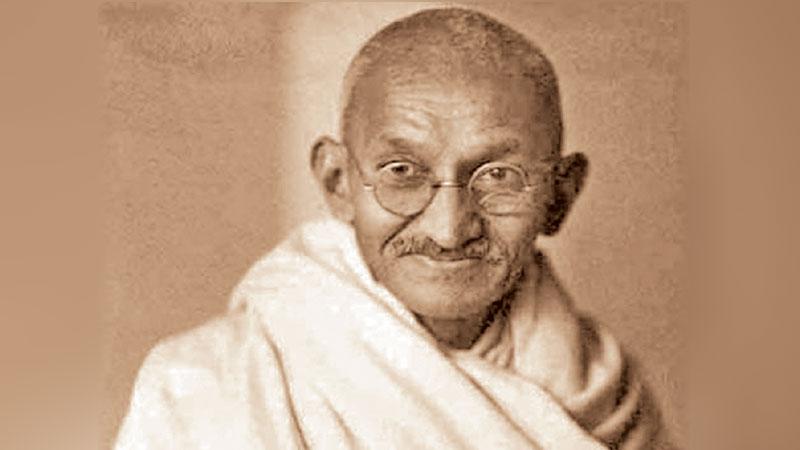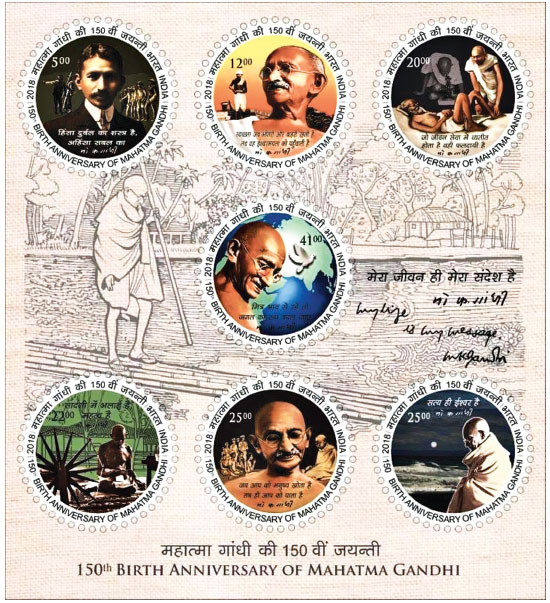
“Mahathma Gandhi was no ordinary leader. There are those who believe he was divinely inspired, and it is difficult not to believe with them. He dared to exhort non violence at a time when the violence of Hiroshima and Nagasaki exploded on us; he exhorted morality, when science, technology and the capitalist order had made it redundant; he replaced self-interest with group interest without minimizing the importance of self.”
-South African Leader Nelson Mandela.
(1918 – 1995)
In the extensive history of human culture, the Indian subcontinent has acquired the lasting reputation for enabling the emergence of spiritual leaders of unquestioned, timeless nobility and universality.
 The supremely enlightened Buddha, widely recognised as the greatest human being, who ever lived, is the most glowing instance of this spiritual glory of India.
The supremely enlightened Buddha, widely recognised as the greatest human being, who ever lived, is the most glowing instance of this spiritual glory of India.
In the succeeding eras too, India’s men of high and pre-eminent presence, possessed, at least some traces of these personality elements of the supreme Buddha, as they were part of the spiritual discipline imposed by traditional Hinduism.
Some of those spiritual elements were renunciation, tapas (austerity), self-mortification and extreme self-restraint.
In modern times, Swami Vivekananda, Rabindranath Tagore, and other outstanding individuals, shared at least vestigial elements of the life of Prince Siddhartha. Youthful Tagore had an exceptionally well-protected domestic life, somewhat similar to the childhood of Prince Siddhartha.
This is true even of the early life of Gandhi. Selfless service dominated his childhood days. He deliberately eschewed ostentatious displays of self-importance. For three generations from his grandfather, his ancestors had been Prime Ministers in several Kathiawal States.
This way, young Gandhi, came from a family background of privilege. As Mahathma himself has said, his life’s aim was attaining ‘moksha’ (Liberation). Karamchand Gandhi, also known as Kaba Gandhi, was Mahathma’s father. At one time, father Kaba was Prime Miister in Porbandar.
Mahathma’s father married four times. Mahathma was the youngest child by his father’s fourth wife. In later years, making a quiet and subdued observation about his father’s marriages, Mahathma said: “To a certain extent he might have been given to carnal pleasures.”
Mahathma Gandhi was born on October 2, 1869 and was named Mohandas Karamchand Gandhi.
Succumbing to inescapably rigid Hindu tradition, he married 14-year-old Kasturibai, at the age of 13. At school, Gandhi was, exceptionally bright. He won prizes, effortlessly.
In terms of the decision of his family elders, he decided to travel to Britain for Law studies. In a strange encounter young Gandhi came upon, Sir Edwin Arnold’s English version of “Bhagavad Gita” (Song Celestial), while in London. That is not all. There he read, Sir Edwin Arnold’s “Light of Asia” with greater interest (Gandhi has recorded) than Sri Edwin Arnold’s translation of “Bhagavat Gita”. A spiritual reawakening arose in London.
Sojourn
With the maturity he acquired in the course of his sojourn in London, he returned home. But, the atmosphere of ‘home’, disappointed Gandhi on several counts. His parents were gone. His employment opportunities seemed rather slim. In such a negative kind of context South Africa beckoned.
Mahathma Gandhi’s epic, selfless and single-minded dedication to the championing of the cause of the underprivileged, helpless, poverty-stricken enslaved and relentlessly exploited masses, had its historical beginnings in the land that hosted him, when he was being troubled by a nagging feeling of lost moorings.
Nelson Mandela, the illustrious South African leader, who fought ferociously and suffered grievously, to blot out “apartheid” that cruelly trampled human dignity, underfoot, records Gandhi’s presence in South Africa: “India is Gandhi’s land of birth; South Africa his land of adoption. He was both an Indian and South African citizen. Both countries contributed to his intellectual and moral genius, and he shaped liberatory movements in both colonial theatres.” Gandhi arrived in South Africa in 1893 at the age of 23. Though he was shocked to the very depth of his soul, when he experienced the diabolical degrading of humans for their colour, he stayed on determined to restore humanity to humans.
Mahathma Gandhi left South Africa in 1914, after a stay of 21 years. He arrived in India armed with fasting, ahimsa and Satyagraha as his unvanquishable weapons and the arms that befit a Mahathma.
His sustained struggle, to free his motherland from colonial domination, landed him, on many an occasion in jail. Mahathma Gandhi, staged history’s most graphic protest march, when he started to walk 200 miles (400 kms) from Ahmedabad to the Arabian Sea. Contemporary reports say, Mahathma Gandhi walked nearly 400 km in 24 days. At each rest step, he would explain his mission to the people and would invite them to join. Though the protest started with a handful of persons, according to reports, the masses thronged until the line of humans extended over a length about 3 kms.
Described as the Salt March, this could very well be the longest line of protesters in modern times. Some British administrators have viewed it as the “Most colossal experiment in human history.”
The real miracle for most, is that, the living core of this massive Movement for Independence was a frail individual, of the simplest of habits and needs. His austerity was severe. Each Monday was a day of silence for him. His meals consisted of the barest of vegetarian content. He spent a few hours each day spinning yarn on his ‘Charka’ – The spinning wheel.
His associates collected his written and spoken words, assiduously and dutifully. According to the news currently available, these are likely to fill about 90 volumes. Other than on his days of silence, he was available to be spoken to, even when he was at his bath.
He was at times bare in upper body. Usually, he wore a dhoti made of course cloth, and a shawl of the same material.
According to available information, the only worldly possessions he had were some of those clothes, a pair of wooden sandals, a pocket watch, a staff and a pair of reading glasses. I have heard it said, that he had in his purse, a small carving of three monkeys one of them had his eyes covered with his hands. The second had his hands on his mouth. The third had his ears covered with hands. The captions underneath read respectively “See no evil, speak no evil and hear no evil”. The monkeys are quite suitable to adorn the purses of many in our day.
Imperial
The Great Mahathama, waged a sustained weaponless war of Ahimsa, to challenge the widest – spread Empire in world history. Characterised by the sobriquet, “The Empire on which the sun never sets,” this British imperial power, had to yield to the demands of this frail, brown and aged sage, who wielded Ahimsa, and the unfailing mass following and popular adoration.
But, the outcome saddened him deeply. The sub-continental India was divided into three segments – East Pakistan, West Pakistan and India. In the undivided, original land of India, then inhabited by 400 million souls, an immense restlessness erupted-resulting in heart-rending violence. According to some sources more than half-a-million died. About 10 to 12 million migrated to main India, creating a chaos, that took years to settle down to normal.
But, at the end of it all, Mahathma’s Ahimsa, and Satyagraha asserted their astonishing efficacy. Had that stratagem failed, the victims would have increased at least ten-fold.
Above all, in the slip-stream of this catastrophe, mankind inherited a weapon, which will negate the destruction that, other man-made weapons of carriage could bring about. Long after Mahathma Gandhi, Ahimsa has now become a blessed philosophy to avert harm to life. When we remember the Mahathma, on his 149th Birthday, we could enthrone his sacred weapon Ahimsa, as a power capable of healing hate and enthroning friendly co-existence.
But, remembering Mahathma’s Birth Anniversary should never allow us to refrain from recollecting with profound sadness, the final sacrifice Mahathma made, to enable men and women live in a context of freedom, independence and happiness.
Let us look briefly at the day when Great Mahathma’s miracle culminated in the winning of Independence by India. On the night of Independence August 15, 1947, the coterie of celebrities was getting together in New Delhi for a festive dinner. But the Great Mahathma, was fasting in a dilapidated shelter in Calcutta, the most fissionable centre that night, in the whole of India. He remained there, offering himself as the sacrifice, to quell the violence, which was quite likely to spread for and wide, if it happened in that city.
When we remember the Great Mahathma we are all under obligation to be exceptionally alert to the high significance of this occasion. We should not allow this commemoration to slip into a mere routine birthday celebration.
We must have it indelibly etched in the deepest inner recesses of our soul, that we are celebrating the 149th. Birth Anniversary of a person, who belongs in the exclusive category of the greatest human beings who ever lived.
He introduced the concept of Ahimsa – nonviolence, as a miraculous device, that can infuse love, compassion and friendly co-existence, to human lives, both today and tomorrow. Let us honour him, by practising Ahimsa, love, compassion and kindness, in the course of our daily relations.
Finally, he sacrificed the only thing he possessed – his life that too for the sake of human well-being. The tragic story of his sacrifice has been dutifully recorded by an internationally reputed communications chronicler. His words have a potentiality to move us profoundly.
Just a few months after the declaration of Independence of India, this heart-rending news-item travelled right across the world.
Pergola
Date: February 9, 1947 “With his arms round the shoulders of his grandnieces, Ava and Manu, the brown man shuffled weakly down the red sandstone pathway leading from Birla House to the vine-covered pergola which served as his prayer meeting place. Slowly he climbed the three steps leading to the pavilion. A stocky young man in grey slacks, a blue pullover and khaki bush jacket stepped forward and knelt at Gandhi’s feet. He was Nathu Ram Vinayak Godsse, editor of the extremist newspaper ‘Hindu Rashtra’, which had denounced Gandhi as an appeaser of Moslems. “You are late today for the prayer,” said the murderer. “Yes, I am”, said Gandhi.
Godse suddenly pulled out a tiny Beretta automatic pistol. He fired three times. One bullet ripped into Gandhi’s chest, two into his belly. With hands folded, as if welcoming the blow, in the gesture that is both the Hindu greeting and the Christian attitude of prayer, Gandhi fell backward. He murmured “Ai Ram, Ai Ram” (O Rama, O Rama), in invocation to the gentle Hero of the Hindu Pantheron, Gandhi’s favourite”.
Mahathma Gandhiji, lived and sacrificed his life for each and every human being on earth.
Therefore, to celebrate his Birthday with greater effectiveness, we must attune ourselves to say Ahimsa, Ahimsa, (non violence, non violence) as a manthra, to appease the evil influences that swarm around us nowadays.
When mankind begins actively to practice Ahimsa, non-violence, metta and karuna, every day, we will be celebrating the birth and life of the Mahathma, on an uninterrupted basis.
